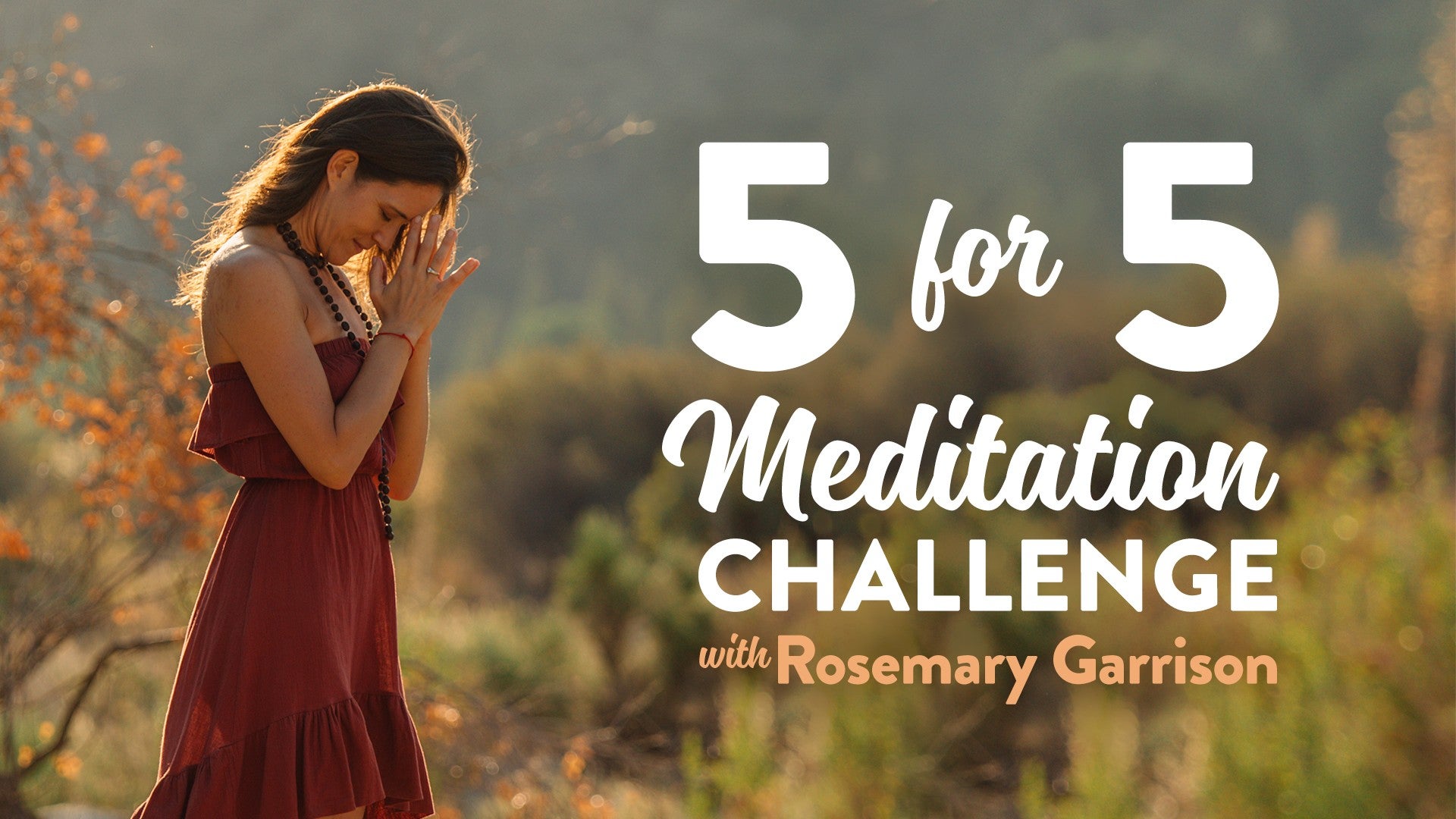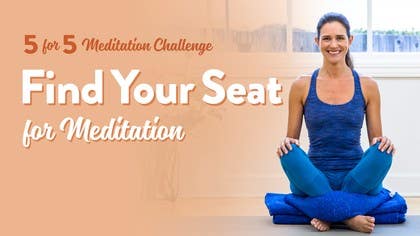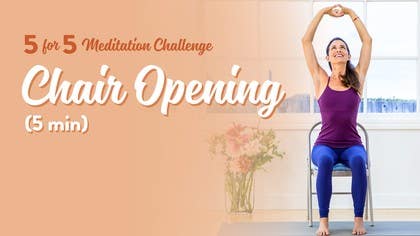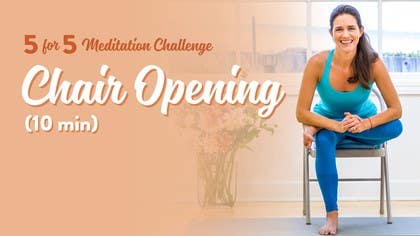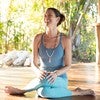Description
About This Video
Transcript
Read Full Transcript
Welcome, everyone. We're going to cover a handful of different ways to sit comfortably, as comfortably as possible. Most of us spend the majority of our days seated, but not necessarily super skillfully, so hopefully we can address some things that will help to support you and help you sit comfortably in your meditation. I want to begin by saying that it's not easy. It seems so simple just to sit down, but to find a really comfortable seat for more than a few minutes can be challenging.
So be patient with yourself, explore a lot of different options, keep exploring different options, and see what works for you. A little bit of discomfort, not at all uncommon, but we don't want to be in pain when we sit. All right? So we'll explore sitting on a chair, sitting on the knees, and an easy cross-legged position propped up on blankets. First one.
We're on a chair. I am on a blanket on top of a chair. Depends on what you're sitting on and the proportion of your legs with the chair and the floor. We want the feet essentially under the knees, and if you find your chair is pretty high up off the ground, your feet are suspended, obviously get something to support them. If you're too close to the ground, you can slide a blanket under the sit bones.
It can also just be really cushy for the butt. Okay. From there, let's take the hands to the hips and see if you can just kind of find your hip bones. Yeah? It's a good little benchmark as you tilt the pelvis forward and back, and kind of notice your tendency.
Do you tend to spill forward with the belly? Do you tend to kind of roll back, falling into the low back, and see if you can rock a little to find the middle path so that you're right on the sit bones, not pitching forward and not collapsing back. Okay? From there, let your hands rest either up or down on the thighs, or if you like palm resting and palm at the base of the lap, that can be kind of holding, grounding. From the steady seat, steady legs, we want to start to lengthen the spine all the way up that central channel.
It can be helpful to think about it rising beyond the crown of the head so that it lengthens the whole torso, keeps that energy rising, right? As it rises, we keep everything around it kind of soft. Maybe draw the shoulders back and roll them down. Relax the jaw. Notice if you've lost that balance through the seat, there can be a slight engagement through the core to keep lengthening and supporting the low back, but not too much hardening or efforting.
And then, check in with the neck and the head, right? Most of us start to develop this tendency of pitching forward, right, with the phones and the computers and the driving, and we want to draw back so that the head is neutral. And balanced, right, on the spine. Jaw is soft, kind of lifting the base of the skull, that same energetic lift up through the crown of the head, yeah? And eyes are soft, ultimately finding some ease with the noble effort, right?
I think that middle path, right? And I invite you to just take a couple breaths here with a soft gaze. Notice how it feels in your body. Notice if you want to make any slight, subtle adjustments. Just tuning in so that you're feeling it from the inside out, right?
Okay, so that's your chair option. If you like that, stay right there. If you want to explore kneeling, we'll just move the chair off to the side. And then, I love to have a blanket under my knees when I'm kneeling, it's just a lot of pressure on the bones without that added support. So get your blanket all laid out, and I'm gonna start with two blocks, because why not?
And stack them wide, and I'll turn this way so that you can see the placement of the blocks between my feet. And then come forward, knees together if possible, right? And then the blocks are just kind of between the ankles or the shins, depending, and we ease back onto that top block. So this option can be really nice if you have very tight hips, and sitting in a more cross-legged position is a little bit tricky. Up on two blocks gives you a lot of support.
And let's just review what the spine is doing, okay? So hands again, up or down on the thighs, or maybe palm and palm. And that middle path, maybe rocking gently a little forward and back on the sit bones till you feel that you're in equilibrium. And from that steady kind of balanced foundation, you want to lengthen all the way up through the spine again, lifting the base of the skull, lifting through the crown of the head. Find the ease, the release through the shoulders.
Back in, make sure you're not pitching forward through the head and the neck, but just settling back, right? And if this feels really comfortable, more gentle on your knees, you're welcome to stay on two blocks. It can feel really supportive. If it's effortless and you'd like to come a little bit closer to the earth, just remove one block and sit a little bit closer to the earth, right? This of course is also known as Virasana, if that's a familiar word to you.
Hands up or down or at the base of the lap. Check in, notice how the knees feel. Find that steadiness through the seat, length through the spine, slight, very slight lift through the center so you're not collapsing in the low back, soft through the shoulders, soft through the neck. And again, I really want to give you a moment or two here, maybe even close the eyes, but take at least a few breaths to notice how this feels in your body. Do you feel supported?
Is it comfortable? Is anything off balance? Is anything tweaking a little bit? You really want to move your awareness through the whole body and make any adjustments you may need, right? Let's take a breath or two in silence.
Okay. So that is the kneeling option, from here we're going to start to explore some different cross legged seats. So I'll move the blankets and the blocks off to the side for the time being and keep this one handy. We're going to do a fun trick with that in a moment. And then start with two.
So maybe you have two, maybe you have three or four or five, maybe you have one or none. It's entirely up to your body, there is no right or wrong here. You're just exploring what works for you. So oftentimes we come into sitting on the ground and the knees are pretty high up. And that's not a lot of fun to support on your own for an extended meditation.
So we'll grab this additional blanket, you want it the longer side, and then just start to roll it up nice and tight, right? Take it on top of the ankles and then just kind of tuck it under the base of the bum, right? You make a little nest for your body. And this essentially holds the legs in place so that you're not having to support them on your own. And just gently rest the hands on the knees, so supportive.
And check in, see how that feels, right? Maybe you want an extra blanket, maybe you feel a little too high and you want to remove one. Give it a moment, see. And if you feel like the hips are a little bit more open and you can remove this, we'll take it another step. So for now, this just goes off to the side and we'll nestle onto the sit bones and see if the knees can come down, okay?
If you're here and your knees are popping up and the back is rounding, then you want to go back to that previous variation because this is just not good, not comfortable, not good for your beautiful body. Okay, then on the sit bones, and resting the hands, and again, those same essential principles, finding the equilibrium on the sit bones, not dropping back, not spilling forward, finding the middle path. And from the steady foundation, that beautiful length, all the way up the spine through the crown of the head, lifting the bottom of the skull, notice again, if you're reaching out, draw that back. It's like calling your energy back into your own body and just reconnecting to your own center, okay? And check in with the shoulders, maybe draw them up, pull them back and drop them down, beginning to open through the chest.
Notice if there's any unnecessary holding in the jaw, let that go. Same with the eyes and the brow, let that go. Let's take a couple breaths of stillness here together so you can move your awareness through the body and notice if you want to make any subtle changes. Really the idea, again and again, is to feel this in your own body from the inside out. So once you've tried any of these positions, really give yourself a moment to check in how it's working for you, okay?
All right. And if there's something else entirely that I haven't offered, feel free to explore that. Maybe you'd like to sit up against a wall, give your back a lot of support or something else and please, as you're working with this, continue to explore different options, right? If you're not really dialed into one that works for you, just keep experimenting. Please feel free to reach out and ask questions.
Be really fun to dialogue about it a little bit. And if you do have a seat that just drops and lands and beautiful, stay with that, okay? Just one more reminder that it really, it's not easy. Even if you've been sitting for a while, it can be challenging. It asks a lot of the body, a lot of the back muscles.
So be patient with yourself, be kind to yourself, explore and hopefully enjoy. Namaste.
5-Day Meditation Challenge
Comments
You need to be a subscriber to post a comment.
Please Log In or Create an Account to start your free trial.
